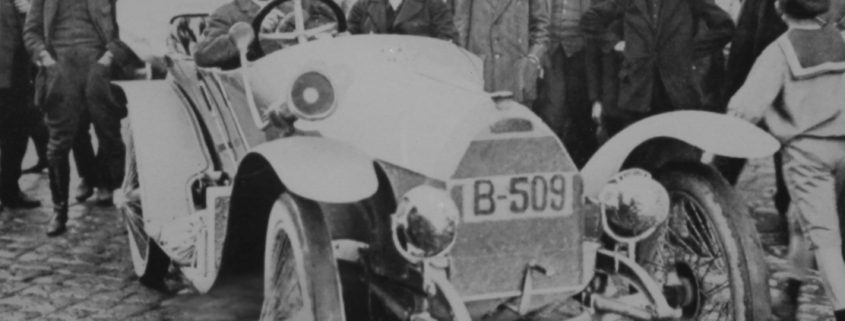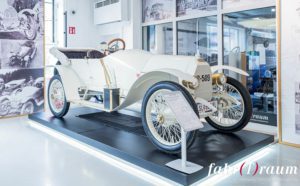Austro Daimler Alpenwagen Year of manufacture 1911 now at fahr(T)raum
The last surviving AD 9/27 Alpenwagen stands in Mattsee
The Ferdinand Porsche Erlebniswelten fahr(T)raum Mattsee/Salzburg is currently displaying an AD 9/27 HP Alpenwagen. This sports car – a successful further development of the AD 20 HP – is the only surviving car of this type; one other was destroyed in a fire.
In the autumn of 1910, Austro Daimler, under the technical direction of Ferdinand Porsche completed the Alpenwagen. Contrary to its predecessor, it featured the following technical details: larger valves, shorter inlet port, lighter connecting rods and pistons, an optimised outlet port and a perfectly balanced fly wheel with balancing machine.
Austro Daimler “Alpenwagen” at fahr(T)raum, Mattsee.
The Alpenwagen was manufactured from 1911 until 1922 and underwent extensive modifications to the AD 25 HP in 1918. There are no records about how many Alpenwagen were built in total; estimations range from 100 to 200 vehicles. The Old-timer Exhibition at fahr(T)raum is now presenting the last existing model. The displayed Alpenwagen was completely rebuilt under the guidance of Ernst Piëch and is now exhibited in an as-new condition.
The success of the Alpenwagen became evident as early as 1911, when it made its debut at the International Non Stop-Alpenfahrt. At that time, it was considered the most difficult, significant and publicity-attracting test drive for touring cars. The Alpenfahrt was an annual event from 1910 until 1914, organised by the K.K. Österreichischen Automobilclub.
During the drive in 1911, there had been four non-stop legs over a total of 1424 km and six alpine passes. The touring cars had to be in operation non-stop for four consecutive days – incredible even at today’s standards.
The first leg went for 315 km from Vienna to Aussee. The second leg went from Aussee to Trieste (404 km). The third leg comprised 303 km from Trieste to Klagenfurt. The fourth and last leg went from Klagenfurt back to Vienna over a distance of 404 km. The motor was not allowed to stop throughout the entire drive; otherwise, penalty points were awarded. The Austro Daimler factory team with the pilots Ferdinand Porsche, Eduard Fischer and Heinrich Graf Schönfeld absolved the entire race without penalty points and won the large gold medal.
Quellen
Bildnachweis
Foto Alpenwagen © Taro Ebihara
Das könnte Sie auch interessieren:








NEW at fahr(T)raum: Steyr Type 30 Cabriolet (1931)
/in Geschichte, News, Sonstige FahrzeugeFerdinand Porsche, who has gone down in history as a pioneer of automotive engineering, developed a car for the upper middle class for the Steyr-Werke in 1929: following his career as Technical Director at Austro Daimler (1906-1923). He very advantageously reengineered, as instructed by Steyr, the Steyr type XX and created a substantially new model […]
Now on exhibit at fahr(T)raum: the world´s only Austro Daimler ADV Boat Tail!
/in Geschichte, News, Sonstige FahrzeugeThe last design which Ferdinand Porsche engineered as technical director for Austro Daimler is now on display at fahr(T)raum Mattsee: the Austro Daimler ADV Boat Tail. It was built in Wiener Neustadt in 1923, but it received its unique chassis – the “Boat Tail” – in the 1950s in the USA. The ADV is a […]
New exhibit at fahr(T)raum – 1916 Austro Daimler 2-cylinder Feldbahn engine
/in Geschichte, Motoren, NewsField and industrial railways (Feldbahnen) have assisted the transport of agricultural, forestry and industrial raw materials and products since the 19th century. They offered high transport performance with simultaneous low energy consumption (low rolling resistance of the wheel-rail system). Their use is mainly associated with the processing industry, such as, e.g., chamotte or sugar factories […]